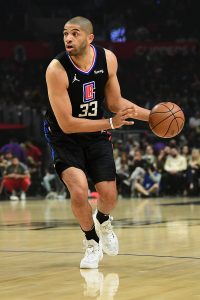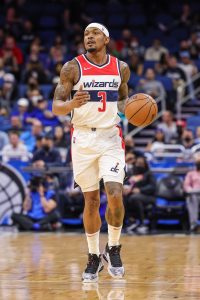A new NBA season brings with it the promise of a new NBA All-Star Game. And though the actual Sunday games themselves have almost totally lost their luster over the last decade or so, qualifying for the contest itself remains a very big deal for every stripe of player.
Last year, there were seven first-time honorees: Ja Morant, Andrew Wiggins, LaMelo Ball, Dejounte Murray, Fred VanVleet, Jarrett Allen and Darius Garland. Many of those first-timers seem likely to return this season, but invariably some will fall short.
For the 2022/23 season, it seems quite possible that several young hoopers on the rise can take the next steps and reach All-Star glory.
This writer’s smart money is on Timberwolves shooting guard Anthony Edwards, who enjoyed a breakout 2021/22 sophomore season in Minnesota — and not just because today is his 21st birthday. The 2020 No. 1 draft pick out of Georgia increased his output across the board, evolving into a two-way leader for a scrappy playoff-bound Timberwolves club that almost clawed its way past the Grizzlies in a hard-fought first-round matchup.
Across 72 games for the 46-36 Timberwolves, the hyper-athletic 6’4″ wing averaged 21.3 PPG, 4.8 RPG, 3.8 APG, 1.5 SPG and 0.6 BPG. His shooting from the floor improved markedly season-to-season, as he converted 44.1% from the field last year, including connecting on 35.7% of his 8.4 three-point attempts.
Though big man Karl-Anthony Towns was Minnesota’s lone All-Star representative last season, Edwards’s two-way contributions on what projects to be an improved Timberwolves roster could help him a first-time All-Star in 2023. Of course, the addition of three-time Defensive Player of the Year Rudy Gobert alongside Towns means that there are two current multi-time All-Stars nominally ahead of Edwards in the team’s pedigree pecking order. But Edwards has more intriguing two-way upside at this juncture than his starrier comrades.
Reigning Raptors Rookie of the Year forward Scottie Barnes looked like a seasoned pro during his inaugural NBA season. Though VanVleet wound up representing Toronto at the 2022 All-Star Game in Cleveland, Barnes’s ceiling is sky-high. Barnes faces some competition from another teammate for All-Star honors next year. Following a slow start, Raptors forward Pascal Siakam rounded into form by the end of the season, making the All-NBA Third Team. Barnes averaged 15.3 PPG, 7.5 RPG, 3.5 APG, 1.1 SPG, and 0.7 BPG in 74 games played for Toronto, all starts. The team finished the season sporting a 48-34 record, good for the fifth seed in a crowded Eastern Conference.
Despite a disappointing 2022 Western Conference Semifinals performance, Suns big man Deandre Ayton was at the the center of significant speculation this summer. The 2018 No. 1 pick became a restricted free agent, and his fate seemed a bit up in the air when free agency opened. For a while, speculation ran rampant that he could become the focal point of a trade for Nets All-Star Kevin Durant. Later, the Pacers tendered Ayton a maximum four-year, $133MM offer sheet, which Phoenix opted to match. He will remain with the Suns until at least January 15, 2023. There’s a reason Ayton was so coveted: the 24-year-old big man is already an excellent player on both sides of the floor. Should he boost his offensive output this season, he may finally reach All-Star status — with the Suns or elsewhere.
Pistons second-year point guard Cade Cunningham will be joined by a flurry of exciting young prospects this season, chief among them 2022 lottery picks Jaden Ivey and Jalen Duren. Cunningham rounded into form down the stretch of the regular season and joined Barnes on the 2022 All-Rookie First Team. At 6’6″, the jumbo-sized lead guard finished with 17.4 PPG, 5.6 APG and 5.5 RPG on a bottom-feeding Pistons team. Should Detroit rise through the standings to around .500 territory, it seems quite possible that will be as a result of the 20-year-old’s contributions.
Another terrific 2022 All-Rookie First Teamer, Cavaliers big man Evan Mobley, formed a formidable front line tandem alongside first-time 2022 All-Star center Allen. Along with All-Star guard Garland, the trio was largely responsible for Cleveland doubling its win total from the (shortened) 2020/21 season, from a 22-50 record to a 44-38 mark. Mobley’s defense played a major role in that turnaround, while his offense was nothing to sneeze at either. The seven-footer averaged 15.0 PPG on 50.8% shooting from the floor, plus 8.3 RPG, 2.5 APG, 1.7 BPG, and 0.8 SPG in 69 games.
All-Star point guard Ja Morant led the Grizzlies to a surprisingly robust No. 2 seed in the West this season, but he didn’t get there alone. Breakout shooting guard Desmond Bane and 2022 All-Defensive First Team power forward Jaren Jackson Jr. provided ample two-way support for their turbocharged lead ball handler. If Memphis’ team success continue this season, either of those players could make the All-Star cut.
Sixers guard Tyrese Maxey had a better postseason run for Philadelphia in 2022 than his inconsistent All-Star teammate James Harden, who has not looked the same since being hampered by a hamstring injury while with the Nets in 2020/21. The third-year swingman could lap Harden and become the Sixers’ second All-Star inclusion this year alongside All-NBA center Joel Embiid. In his second NBA season, Maxey averaged 17.5 PPG, 4.3 APG, and 3.2 APG on .485/.427/.866 shooting splits. In the playoffs, he averaged 20.8 PPG, 3.9 APG, 3.5 RPG, and 0.8 SPG.
Nuggets guard Jamal Murray seemed to be on-track for All-Star inclusion prior to suffering the ACL tear that knocked him out of the conclusion of the 2020/21 NBA season and the entirety of 2021/22. Should he return to his pre-injury productivity while helping current MPV Nikola Jokic lead Denver to a top-four seed in the Western Conference, Murray may finally be able to make his first All-Star team. Across 48 games in 2020/21, Murray averaged 21.2 PPG, 4.8 APG, 4.0 RPG, and 1.3 SPG, with shooting splits of .477/.408/.869.
Other candidates on this writer’s list include the Heat‘s Sixth Man of the Year Tyler Herro, new Knicks point guard Jalen Brunson, and maybe, just maybe, productive young guards Tyrese Haliburton and Shai Gilgeous-Alexander, two players saddled with teams that appear poised to tank in 2022/23. But things can change.
We want to know what you think. Will any of the aforementioned NBA player(s) make their All-Star debuts in Salt Lake City next February? Do you have someone else in mind to take the leap? Head to the comments section below and let us know!

